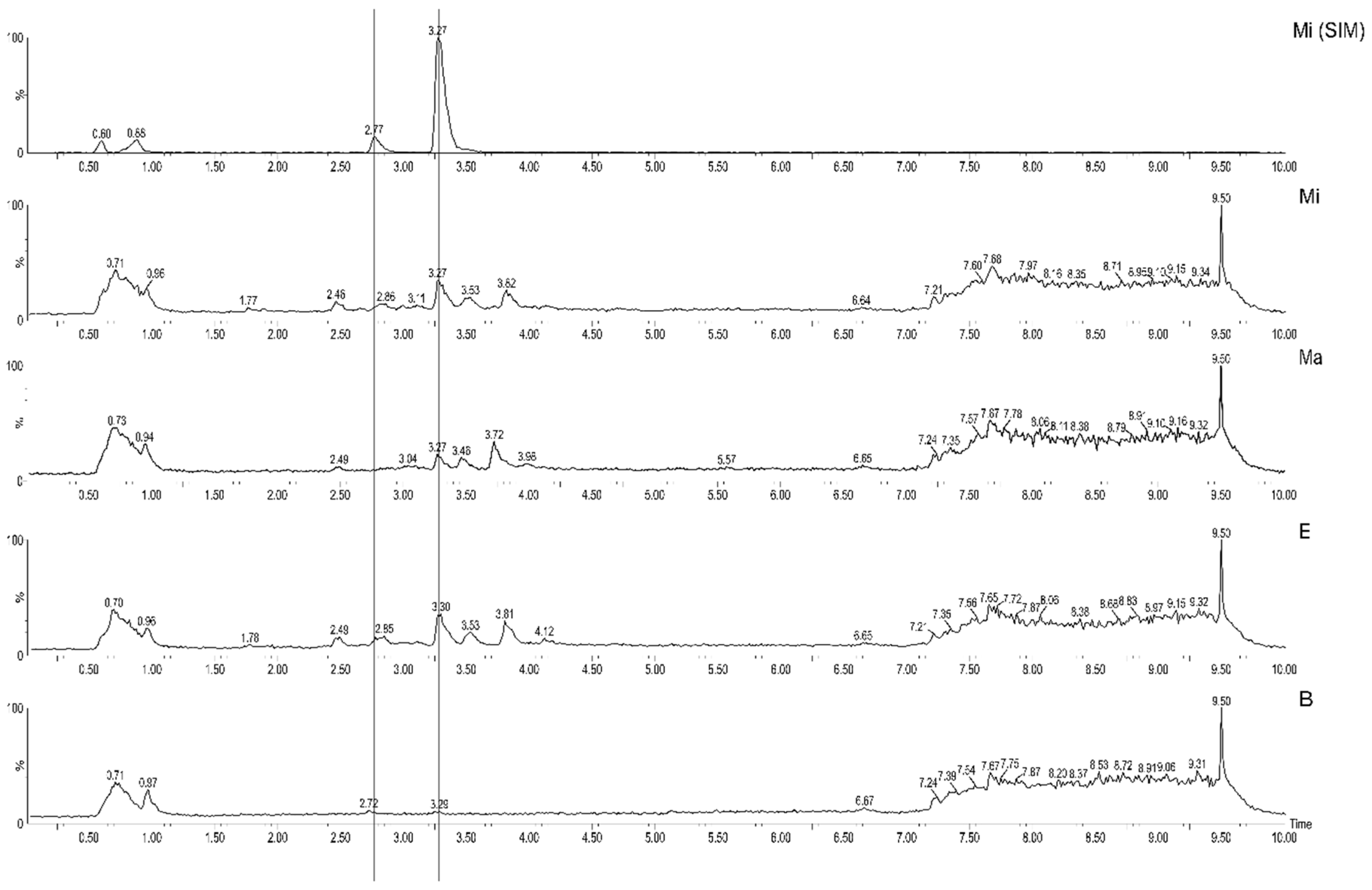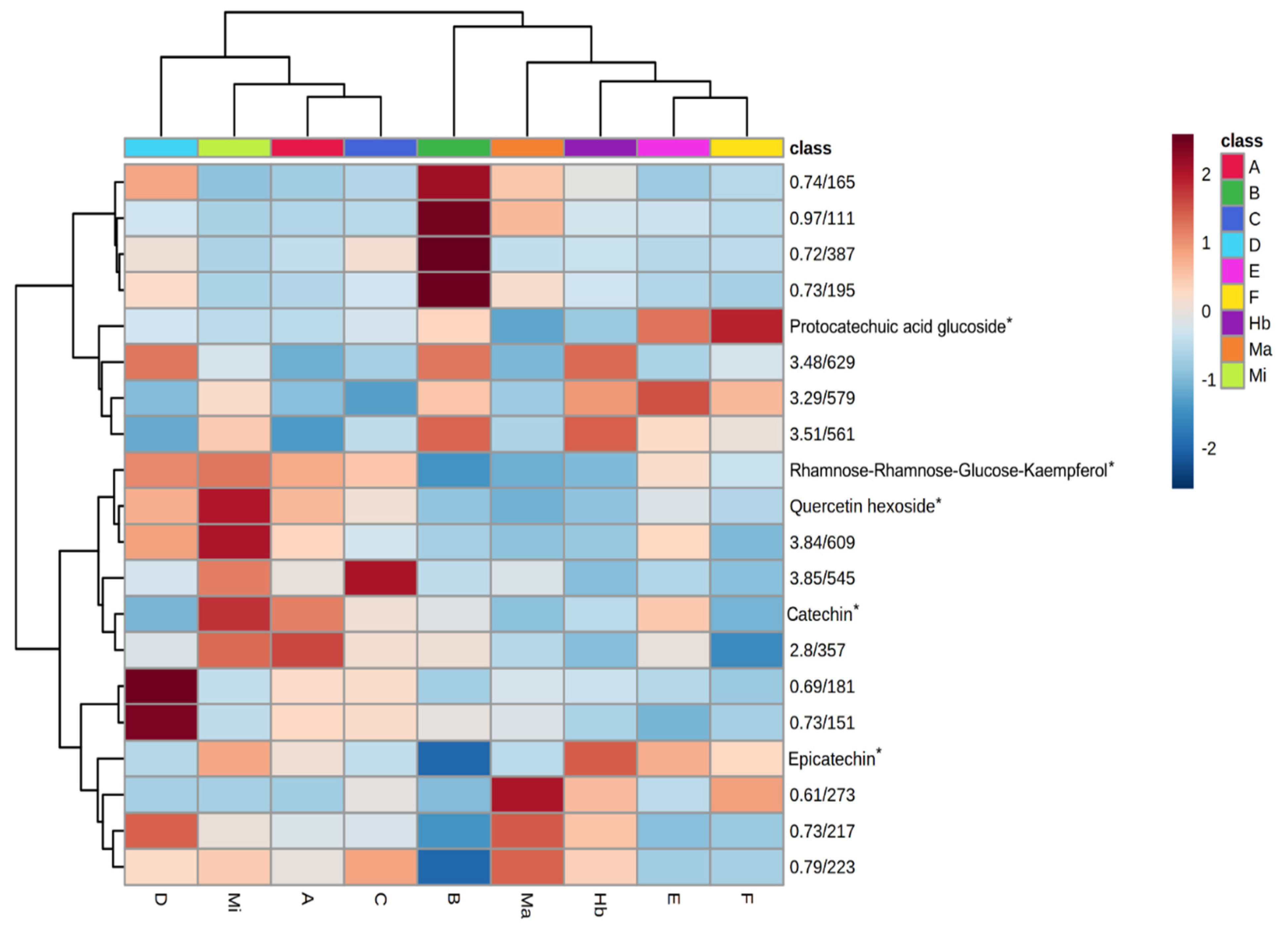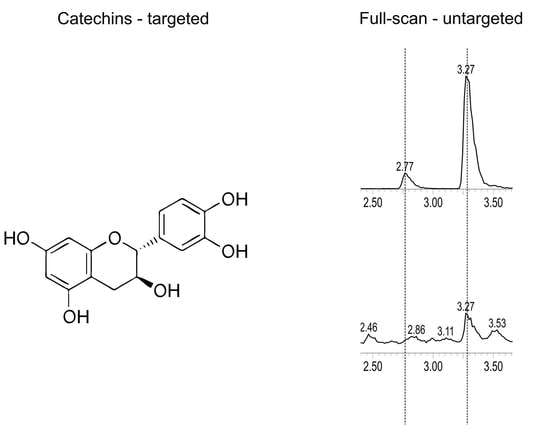Simultaneous UHPLC-MS Quantification of Catechins and Untargeted Metabolomic Profiling for Proof-of-Concept Authenticity Determination of Maytenus ssp. Samples
Abstract
:1. Introduction
2. Results and Discussion
2.1. Analytical Method Validation
2.2. Quantification and Metabolomics
3. Materials and Methods
3.1. Plant Material
3.2. Sample Extraction
3.3. Analytical Method
3.4. Untargeted Processing of Full-Scan Chromatograms
4. Conclusions
Supplementary Materials
Author Contributions
Funding
Institutional Review Board Statement
Informed Consent Statement
Data Availability Statement
Acknowledgments
Conflicts of Interest
References
- Tiberti, L.A.; Yariwake, J.H.; Ndjoko, K.; Hostettmann, K. Identification of flavonols in leaves of Maytenus ilicifolia and M. aquifolium (Celastraceae) by LC/UV/MS analysis. J. Chromatogr. B 2007, 846, 378–384. [Google Scholar] [CrossRef] [PubMed]
- Da Saúde Brasil, M. Relação Nacional de Medicamentos Essenciais−RENAME 2020 no âmbito do Sistema Único de Saúde (SUS). 2020. Available online: http://bvsms.saude.gov.br/bvs/publicacoes/relacao_medicamentos_rename_2020.pdf (accessed on 22 August 2022).
- Anvisa, Memento Fitoterápico, Anvisa, Brasilia, Brazil. 2016. Available online: https://www.gov.br/anvisa/pt-br/assuntos/farmacopeia/formulario-fitoterapico/MementoFitoterapico1.pdf (accessed on 22 August 2022).
- Farmacopeia Brasileira, 6th ed.; Volume 2, 2019. Available online: https://www.gov.br/anvisa/pt-br/assuntos/farmacopeia/farmacopeia-brasileira/6a-edicao-volume-2 (accessed on 22 August 2022).
- Niero, R.; De Andrade, S.F.; Filho, V.C. A Review of the Ethnopharmacology, Phytochemistry and Pharmacology of Plants of the Maytenus Genus. Curr. Pharm. Des. 2011, 17, 1–21. [Google Scholar] [CrossRef] [PubMed]
- Gonzalez, F.G.; Portela, T.Y.; Stipp, E.J.; Di Stasi, L.C. Antiulcerogenic and analgesic effects of Maytenus aquifolium, Sorocea bomplandii and Zolernia ilicifolia. J. Ethnopharmacol. 2001, 77, 41–47. [Google Scholar] [CrossRef]
- Games, R.A.T. Contribuição ao Controle de Qualidade da Espinheira-Santa. Master’s Thesis, UNIBAN, São Paulo, Brazil, 2020. [Google Scholar]
- Sánchez-Rangel, J.C.; Benavides, J.; Heredia, J.B.; Cisneros-Zevallos, L.; Jacobo-Velázquez, D.A. The Folin-Ciocalteu assay revisited: Improvement of its specificity for total phenolic content determination. Anal. Methods 2013, 5, 5990–5999. [Google Scholar] [CrossRef]
- Antunes, E.R.M.; Duarte, R.S.; Moritz, T.; Sawaya, A.C.H.F. Differentiation of two Maytenus species and their hybrid via untargeted metabolomics. Ind. Crops Prod. 2020, 158, 113014. [Google Scholar] [CrossRef]
- Mathew, A.K.; Padmanaban, V.C. Metabolomics: The apogee of the omics trilogy. Int. J. Pharm. Pharm. Sci. 2013, 5, 45–48. [Google Scholar]
- Commisso, M.; Strazzer, P.; Toffali, K.; Stocchero, M.; Guzzo, F. Untargeted metabolomics: An emerging approach to determine the composition of herbal products. Comput. Struct. Biotechnol. J. 2013, 4, e201301007. [Google Scholar] [CrossRef] [PubMed]
- Kenny, L.C.; Dunn, W.B.; Ellis, D.I.; Myers, J.; Baker, P.N.; Kell, D.B. Novel biomarkers for pre-eclampsia detected using metabolomics and machine learning. Metabolomics 2005, 1, 227–234. [Google Scholar] [CrossRef]
- Liang, Y.Z.; Xie, P.; Chan, K. Quality control of herbal medicines. J. Chromatogr. B Anal. Technol. Biomed. Life Sci. 2004, 81, 253–270. [Google Scholar] [CrossRef]
- ANVISA. Resolução RDC No 166−Validação de Métodos Analíticos e Outras Providências. 2017. Available online: http://antigo.anvisa.gov.br/documents/10181/2721567/RDC_166_2017_COMP.pdf/d5fb92b3-6c6b-4130-8670-4e3263763401 (accessed on 22 August 2022).
- AOAC. Appendix F: Guidelines for standard method performance requirements. AOAC Int. Off. Method Anal. 2012, 1–18. [Google Scholar]
- Veloso, C.C.; Soares, G.L.; Perez, A.C.; Rodrigues, V.G.; Silva, F.C. Pharmacological potential of Maytenus species and isolated constituents, especially tingenone, for treatment of painful inflammatory diseases. Braz. J. Pharmacogn. 2017, 27, 533–540. [Google Scholar] [CrossRef]
- Holnik, P.R.; Hussein, A.A.; Souza, B.M.C.; Coldbella, P.F.; Shimabaku, R.S., Jr.; Leite, N.K. Comparação do teor de taninos entre duas espécies de espinheira-santa (Maytenus aquifolium Mart. e Maytenus ilicifolia Mart. ex Reissek) cultivadas no Horto Medicinal do Refúgio Biológico Bela Vista−RBBV da Itaipu Binacional−Foz do Iguaçu, PR−Brasil. Rev. Bras. Pl. Med. 2015, 17, 385–391. [Google Scholar] [CrossRef]
- Iacopini, P.; Baldi, M.; Storchi, P.; Sebastiani, L. Catechin, epicatechin, quercetin, rutin and resveratrol in red grape: Content, in vitro antioxidant activity and interactions. J. Food Compos. Anal. 2008, 21, 589–598. [Google Scholar] [CrossRef]
- Ho, C.T.; Chen, Q.; Shi, H.; Zhang, K.Q.; Rosen, R.T. Antioxidative effect of polyphenol extract prepared from various Chinese teas. Prev. Med. 1992, 21, 520–525. [Google Scholar] [CrossRef]
- Santos-Oliveira, R.; Coulaud-Cunha, S.; Colaço, W. Revisao da Maytenus ilicifolia Mart. ex Reissek, Celastraceae. Contribuição ao estudo das propriedades farmacológicas. Braz. J. Pharmacogn. 2009, 19, 650–659. [Google Scholar] [CrossRef]
- Lee, K.M.; Jeon, J.Y.; Lee, B.J.; Lee, H.; Choi, H.K. Application of metabolomics to the quality control of natural product derived medicines. Biomol. Ther. 2017, 25, 559–568. [Google Scholar] [CrossRef] [PubMed]
- ANVISA. Formulário de Fitoterápicos Agência Nacional de Vigilância Sanitária-Anvisa, 2nd ed.; 2021. Available online: https://www.gov.br/anvisa/pt-br/assuntos/farmacopeia/formulario-fitoterapico/2022-fffb2-versao-13-mai-2022.pdf (accessed on 22 August 2022).
- Chong, J.; Soufan, O.; Li, C.; Caraus, I.; Li, S.; Bourque, G.; Wishart, D.S.; Xia, J. MetaboAnalyst 4.0: Towards more transparent and integrative metabolomics analysis. Nucleic Acids Res. 2018, 46, W486–W494. [Google Scholar] [CrossRef] [PubMed] [Green Version]


| Parameter | Standard Values | Calculated Values Catechin | Calculated Values Epicatechin |
|---|---|---|---|
| Homoscedasticity | 0.616 | 0.553 | 0.427 |
| Correlation Coefficient (r) | 0.99 | 0.9971 | 0.9929 |
| Determination Coefficient (r2) | - | 0.9986 | 0.9964 |
| Significance of the Angular Coefficient | 6.12 | 5534 | 2223 |
| Evaluation of the Linear Coefficient (intercept) | 4.30 | 2.00 | 0.00 |
| Independence of Residues | 1.5 | 1.58 | 1.57 |
| Normality of Residues | 0.908 | 0.937 | 0.962 |
| Evaluation of Outliers | 3.00 | No outliers | No outliers |
| Variation (%) Angular Coef. between Solvent and Plant Matrix | - | 1.72 | 2.5 |
| Repeatability (RSD%) | <15 | 6.5 | 4.0 |
| Intermediate Precision (RSD%) | <15 | 7.0 | 5.4 |
| Accuracy (recovery %) | 80–110 | 98.5–109.33 | 97.90–103.12 |
| Detection Limit (µg/mL) | - | 0.03 | 0.03 |
| Quantification Limit (µg/mL) | - | 0.1 | 0.1 |
| Sample Name | Description | Acquired in | Expiry Date | Catechin (mg/g) | Epicatechin (mg/g) |
|---|---|---|---|---|---|
| Mi | M. ilicifolia | CPQBA Campinas/SP | - | 2.0 | 4.4 |
| Ma | M. aquifolium | CPQBA Campinas/SP | - | <LQ | 1.9 |
| Hb | Maytenus hybrid | CPQBA Campinas/SP | - | 0.8 | 4.1 |
| A | brand A (packaged) | Pharmacy Itapira/SP | Apr-19 | 1.0 | 2.3 |
| B | brand B (packaged) | Pharmacy Itapira/SP | Apr-19 | <LQ | <LQ |
| C | brand C (packaged) | Pharmacy Itapira/SP | Feb-19 | 0.3 | 1.1 |
| D | brand D (bulk) | City Market Lindóia/SP | - | 0.4 | 0.9 |
| E | brand E (bulk) | City Market Jacareí/SP | - | 1.3 | 5.5 |
| F | brand F (bulk) | City Market Araraquara/SP | - | 0.7 | 5.2 |
Publisher’s Note: MDPI stays neutral with regard to jurisdictional claims in published maps and institutional affiliations. |
© 2022 by the authors. Licensee MDPI, Basel, Switzerland. This article is an open access article distributed under the terms and conditions of the Creative Commons Attribution (CC BY) license (https://creativecommons.org/licenses/by/4.0/).
Share and Cite
Duarte, R.S.; Antunes, E.R.M.; Sawaya, A.C.H.F. Simultaneous UHPLC-MS Quantification of Catechins and Untargeted Metabolomic Profiling for Proof-of-Concept Authenticity Determination of Maytenus ssp. Samples. Molecules 2022, 27, 5520. https://doi.org/10.3390/molecules27175520
Duarte RS, Antunes ERM, Sawaya ACHF. Simultaneous UHPLC-MS Quantification of Catechins and Untargeted Metabolomic Profiling for Proof-of-Concept Authenticity Determination of Maytenus ssp. Samples. Molecules. 2022; 27(17):5520. https://doi.org/10.3390/molecules27175520
Chicago/Turabian StyleDuarte, Rodolfo Santos, Elisa Ribeiro Miranda Antunes, and Alexandra Christine Helena Frankland Sawaya. 2022. "Simultaneous UHPLC-MS Quantification of Catechins and Untargeted Metabolomic Profiling for Proof-of-Concept Authenticity Determination of Maytenus ssp. Samples" Molecules 27, no. 17: 5520. https://doi.org/10.3390/molecules27175520
APA StyleDuarte, R. S., Antunes, E. R. M., & Sawaya, A. C. H. F. (2022). Simultaneous UHPLC-MS Quantification of Catechins and Untargeted Metabolomic Profiling for Proof-of-Concept Authenticity Determination of Maytenus ssp. Samples. Molecules, 27(17), 5520. https://doi.org/10.3390/molecules27175520







